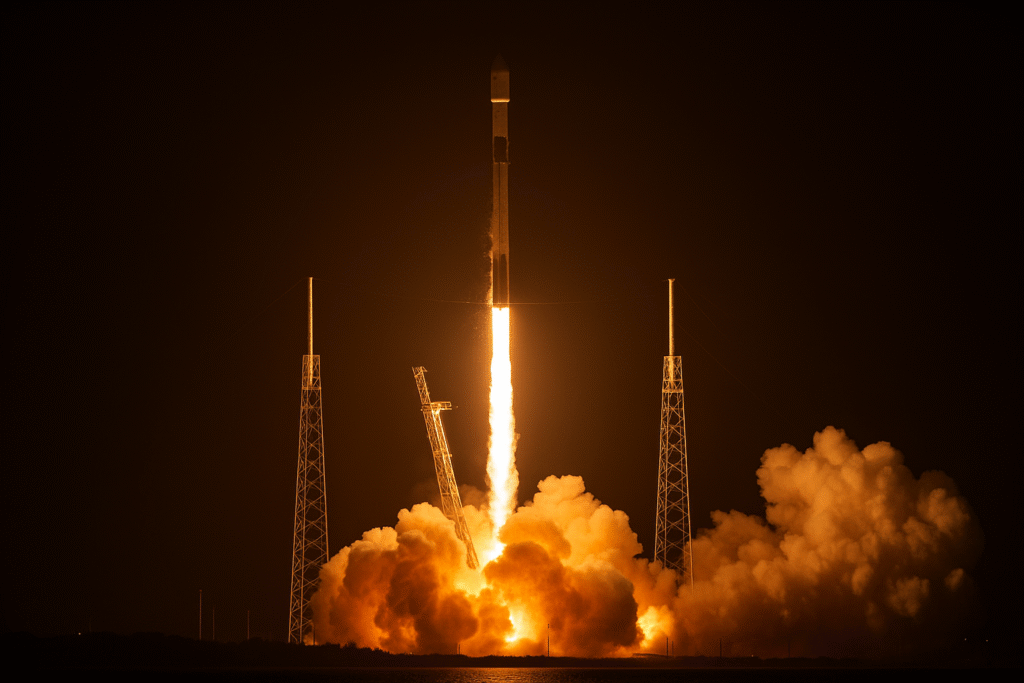In the early hours of Saturday, SpaceX launched 28 Starlink satellites aboard its reliable Falcon 9 rocket from Cape Canaveral Space Force Station. This Starlink satellite launch came barely 36 hours after a rare global outage disrupted internet services for Starlink users across the globe a strategic move by SpaceX, showing both urgency and confidence in its technology.
The timing of the launch speaks volumes. While the world questioned the reliability of Starlink after the extended downtime, SpaceX answered not with excuses but with action. Launching a new batch of satellites so soon demonstrates the company’s commitment to maintaining service integrity and pushing forward in its mission to build a resilient global internet network.
What This Launch Means for Starlink Users
This particular Starlink satellite launch wasn’t just routine it was symbolic. The outage affected customers in the United States, Europe, Asia, and parts of South America. Although SpaceX responded quickly and restored connectivity within a few hours, users were left wondering Can we rely on Starlink in the long term?
According to Dr. Alicia Moore, a telecommunications expert at MIT, A post outage launch like this is rare in aerospace history. It reflects operational maturity and infrastructure readiness. They’re not just launching satellites they’re restoring public trust.
This 28 satellite deployment adds to the growing constellation that now surpasses 6,000 satellites in orbit. With every Starlink satellite launch, the network becomes denser and more robust. That density is critical in minimizing service gaps and ensuring seamless transitions when one node fails or disconnects.
Remote Medical Teams Rely on Starlink
In rural Alaska, Dr. Kevin Brooks runs a small clinic that serves several native communities. Last week’s outage meant the clinic’s access to cloud based patient records and video consultations were cut off for more than two hours. We rely on Starlink because it’s our only high speed option said Dr. Brooks. It was unsettling during the outage, but knowing they’re putting more satellites up reassures me.
Such real world dependency illustrates how Starlink satellite launches are not just tech milestones they have direct, life impacting consequences. In many isolated regions, traditional infrastructure isn’t viable, making Starlink a literal lifeline.
Addressing the Starlink Outage
While outages in space based systems aren’t entirely avoidable, transparency and redundancy are critical. Elon Musk tweeted that a network software configuration error led to the global disruption, which was then patched rapidly.
John Krikorian, a systems engineer and former NASA consultant, remarked. SpaceX is agile. They can diagnose, patch, and scale faster than most government backed operations. What makes Starlink special isn’t just hardware it’s the responsiveness of the team behind it.
The recent Starlink satellite launch is part of that responsiveness. It expands redundancy, which reduces risk in the event of another anomaly. With each Falcon 9 mission, Starlink’s global mesh becomes less vulnerable to single points of failure.
A Digital Nomad’s Perspective
Sandra Lin, a travel blogger and digital nomad currently in Patagonia, shared her take. Starlink lets me work from anywhere literally. The outage was a reminder of how reliant I am on it, but seeing how fast they followed it up with another launch gave me confidence. It feels like they’re listening.
Sandra’s sentiments are echoed by thousands of users who, despite frustration, see SpaceX’s proactive move as a signal of long term commitment to connectivity.
The Bigger Picture: Why This Launch Matters
This Starlink satellite launch also highlights broader ambitions. SpaceX isn’t just building internet infrastructure it’s shaping the future of global communication. From disaster response teams in war torn regions to scientists conducting fieldwork in Antarctica, Starlink is enabling real time connectivity where it never existed.
According to satellite policy analyst Rachel Nguyen, This launch after a failure is a business and PR masterstroke. It’s rare to see such aggressive iteration outside of Silicon Valley, let alone in aerospace.
Indeed, Starlink is beginning to resemble not just a service but a utility like electricity or water essential and expected. The trust people place in it will depend on how SpaceX manages risk, communicates transparently, and continues launching consistently.
What Comes Next for Starlink and SpaceX?
The successful deployment from this Falcon 9 mission signals a return to normal operations but with a heightened sense of responsibility. Starlink is expected to enter new markets in Africa and South Asia in Q3 2025, and this launch paves the way for that expansion.
SpaceX also plans to begin deorbiting older satellites and replacing them with more advanced V3 models. These newer satellites will offer higher bandwidth, laser-based inter satellite links, and improved energy efficiency.
SpaceX Proves Its Resilience with Timely Starlink Satellite Launch
The Starlink satellite launch this Saturday is more than a technological event it’s a message. A message that setbacks are temporary, that innovation is relentless, and that global connectivity is worth fighting for. In the face of service disruption, SpaceX didn’t pause they accelerated.
Through expert engineering, swift decision making, and an unwavering focus on user experience, SpaceX is once again reminding the world why it leads in space based internet. The world watched, and once again, the Falcon 9 delivered.

